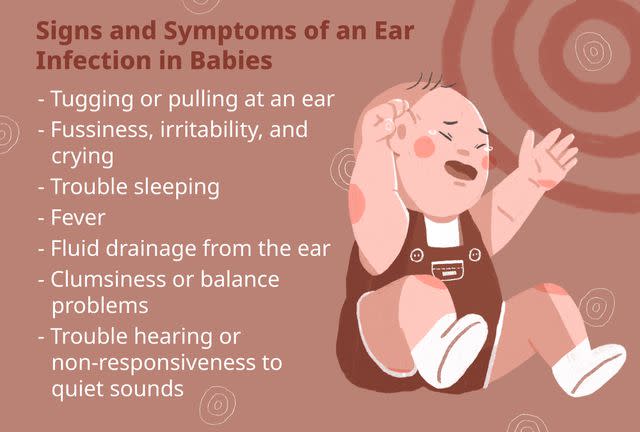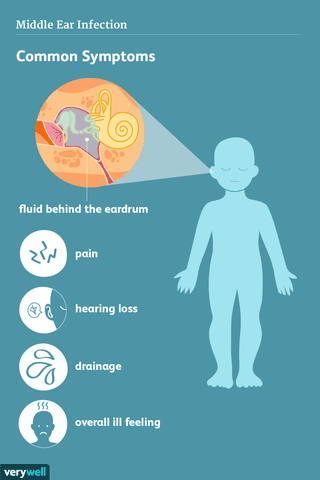Ear Infection Symptoms: Middle, Inner, or Outer Ear Pain
Medically reviewed by Isabel Casimiro, MD, PhD
The symptoms of an ear infection vary by whether the infection is in the outer ear (otitis externa), middle ear (otitis media), or inner ear (otitis interna). Each type affects different organs involved in hearing. Though ear pain is a common symptom. Other signs and symptoms can include hearing loss, vertigo, a loss of balance, ringing in the ears, and fluid discharge from the ear canal.
This article describes the different signs and symptoms of an ear infection in adults and children, including how ear infections happen and when it is time to see a healthcare provider.

Illustration by Julie Bang for Verywell Health
Related: How to Unclog Your Ears
Ear Infection Symptoms: Do I Have Ear Inflammation?
Ear infections are commonly caused by bacteria, viruses, and occasionally fungi or parasites. As it does with all infections, the immune system will respond to an ear infection by producing inflammation.
Inflammation is a defensive response that causes the dilation (widening) of blood vessels to allow immune cells closer access to the site of the infection. This, in turn, generates heat, pain, and swelling of tissues.
Depending on which organs of the ear are affected, an ear infection can cause a cascade of different signs and symptoms, both common and uncommon.
Related: Learn About the Anatomy of the Ear
Symptoms of an Outer Ear Infection
Otitis externa is the inflammation of the ear canal which runs from your eardrum to the outside of your head. It is often called swimmer's ear because it frequently affects people who get bacteria or fungi in their ears from swimming in polluted water.
Swimmer's ear can also occur if your ear gets routinely blocked with water. oversaturating the skin and causing breaks that allow bacteria to enter underlying tissues. Putting cotton swabs or other objects into your ear is a common way to introduce bacteria into the ear canal.
Swimmer's ear is common in children and young adults but can affect people of any age.
An outer ear infection can progress if not properly treated. Symptoms vary by the severity of the infection, as shown in the following table.
Mild Otitis Externa | Moderate Otitis Externa | Severe Otitis Externa |
Mild but persistent itching of the ear canal | Intense itching of the ear canal | Severe pain radiating to the face and neck |
Redness at the entry of the ear canal | Increasing pain | Redness spreading to the outer ear |
Pain when tugging on the ear lobe | Increasing redness and rawness of the ear canal | Swelling and complete blockage of the ear canal |
Possible ear drainage, typically clear and colorless | A feeling of fullness or something being stuffed in your ear | Visible crusting of the ear canal |
| Muffled hearing | Hearing loss |
| More profuse ear drainage | Swollen lymph nodes in the neck |
|
| Fever |
Related: How to Treat Swimmer's Ear
Symptoms of a Middle Ear Infection
Otitis media is inflammation of the middle ear situated just behind the eardrum. It is comprised of three bones called the ossicles. These bones transmit sounds as vibrations to the inner ear and the eustachian tube, the tube connecting to the upper throat that equalizes pressure in the middle ear.

Illustration by Verywell
Otitis media most often occurs when an upper respiratory tract infection triggers inflammation of the eustachian tube and the blockage of fluids in the middle ear. Bacteria and viruses can both cause a middle ear infection. Children are affected far more than adults.
Symptoms of otitis media vary by whether it is acute (sudden and short-lasting) or chronic (persistent or recurrent).
The three types of middle ear infections, which vary by their severity, are:
Acute otitis media (AOM): The infection and inflammation of the middle ear
Otitis media with effusion (OME): AOM with the buildup of noninfected fluid in the middle ear
Chronic suppurative otitis media (CSOM): An ongoing inner ear infection with persistent drainage lasting for more than two to six weeks
Symptoms can differ based on the infection type.
Acute otitis media | Otitis media with effusion | Chronic suppurative otitis media |
Ear pain | Ear pain | Ear pain |
Blocked or muffled hearing | Blocked or muffled hearing, often after the initial infection subsides | Spinning sensations (vertigo) and the loss of balance |
Fever | A feeling of fullness in the ear | Fever |
Possible fluid drainage, usually light and odorless | Ringing in the ears (tinnitus) | A sticky, pus-like discharge from the ear |
| Increasing hearing loss | Crusting of the outer ear canal |
Increasing hearing loss |
Related: Ear Infection in Adults
Symptoms of an Inner Ear Infection
Otitis interna is the inflammation of the central chamber of the inner ear (labyrinth) and/or the nerve that transmits signals from the inner ear to the brain (vestibulocochlear nerve). In addition to translating sound vibrations into nerve impulses, these structures help you maintain balance by constantly relaying information to the brain about the orientation of your head in space.
When the infection affects the labyrinth and vestibulocochlear nerve, it is called labyrinthitis. When only the vestibulocochlear nerve is affected, it is called vestibular neuritis.
Labyrinthitis is most often caused by a virus or bacterium, but there are also noninfectious causes like allergies, cholesteatoma (a benign growth in the ear), and certain medications. Vestibular neuritis is most often seen in people with shingles (herpes zoster virus).
Otitis interna is more common in adults, the symptoms of which vary by the extent of the inner ear involvement.
Labyrinthitis | Vestibular neuritis |
Ear pain | Sudden, severe vertigo and dizziness |
A feeling of fullness in the ear | A feeling of fullness in the ear |
Dizziness or a loss of balance | A loss of balance and falls |
Fluid drainage from the ear, either clear or pus-like | Severe motion sensitivity |
Nausea | Nausea and vomiting |
Tinnitus | Motion sensitivity |
Blurring or changes in vision | Inability to control eye movements (nystagmus) |
Fever | Difficulty walking |
Headaches | Anxiety |
Related: How Vertigo Is Treated
How Do You Spot Ear Infection Symptoms in Children?
Acute otitis media is the most common diagnosis worldwide. Children are affected more than adults, with 70% experiencing at least one episode before the age of 2. This is due in part to the horizontal position of the eustachian tube in babies and toddlers, which collects fluids more easily, as well as the lack of a mature immune system.
Some young children have as many as five or six episodes per year.
Because children of this age usually cannot express what they are feeling, it is important to recognize the signs and symptoms of AOM if they are not old enough to tell you their ear hurts.
Signs and symptoms of an ear infection in babies and toddlers include:
Tugging or pulling at an ear
Fussiness, irritability, and crying
Trouble sleeping
Fever
Fluid drainage from the ear
Clumsiness or balance problems
Trouble hearing or being nonresponsive to quiet sounds
Related: Do Kids Always Need Antibiotics for Ear Infections?
When to Get Medical Help for Severe Ear Infection Symptoms
Ear infections may seem commonplace, but some people are at greater risk of complications than others. These include children whose hearing organs (including the ossicles and cochlea) are delicate and vulnerable to irreversible damage from a severe ear infection.
Certain vulnerable adults can also experience severe complications of an ear infection, including a ruptured eardrum, permanent hearing loss, and the spread of infection to the face, skull, and brain (causing facial paralysis, meningitis, mastoiditis, and brain abscesses).
For children, the Centers for Disease Control and Prevention (CDC) recommends seeing a healthcare provider immediately if your child has:
A fever of 102.2 degrees F or higher (or 100.4 degrees F in infants under 3 months)
Symptoms of a middle ear infection lasting more than one or two days
Pus or fluid discharge from the ear
Worsening symptoms
Hearing loss
Any other symptoms you find concerning
For adults, it is important to see a healthcare provider if you have:
High fever
Symptoms of a middle ear infection lasting more than two to three days
Severe pain and swelling behind the ear
Pus or fluid discharge from the ear
Hearing loss
Facial weakness or drooping
Double vision or a sudden aversion to light
Neck stiffness
Any other symptoms you find concerning
Related: What Causes a Double Ear Infection?
How Long Ear Infection Symptoms Last
Some ear infections can heal on their own and resolve within a few days. Others almost invariably require medical treatment and may take weeks to fully clear.
Outer Ear Infection
Swimmer's ear generally doesn't go away on its own. It usually requires the cleaning of your ear canal by a healthcare provider and prescription ear drops to kill the bacterium or fungus and/or alleviate inflammation.
Treatment is typically prescribed for seven to 10 days. If left untreated, the condition can persist for months and cause damage to the surrounding bone and cartilage as well as nerves of the brain and face.
Middle Ear Infection
Mild cases of otitis media often clear on their own within three to five days, particularly if caused by an upper respiratory virus. Supportive care may be needed to reduce pain and fever.
Bacterial causes may require antibiotics. When treated, ear infections usually resolve within a few days. However, there may be residual fluid trapped behind the eardrum that can take three to six weeks to fully clear.
Antibiotics can usually clear a bacterial ear infection within five to seven days. The drugs are typically prescribed if the infection doesn't improve on its own within 24 to 48 hours due to the risk of hearing loss.
Treatment is considered essential given that otitis media with effusion is the number one cause of acquired hearing loss in kids.
Inner Ear Infection
The treatment of an inner ear infection varies by the cause. Many cases clear on their own without treatment, often within a few weeks but sometimes longer. During this time, medications like Compazine (prochlorperazine) may be prescribed if vertigo is affecting your ability to function.
Other people may require immediate medical care, including those whose symptoms are caused by bacterial meningitis. This condition, characterized by the swelling of the lining of the brain and spinal cord, is a medical emergency that can progress quickly and lead to shock death if not treated appropriately.
Related: Are Ear Infections a Sign of COVID?
Summary
The symptoms of an ear infection vary by whether the infection is in the outer ear, middle ear, or inner ear. Pain, muffled hearing, and fluid drainage are common with all ear infections. Others, like tinnitus, vertigo, hearing loss, and changes in vision, are the primary symptoms of an inner ear infection or signs that an outer or inner infection is worsening.
To avoid severe complications, see a healthcare provider immediately if an ear infection persists, worsens, or is accompanied by high fever, hearing loss, a pus-like discharge, or any other concerning symptoms.
Read Next: How to Prevent an Ear Infection
Read the original article on Verywell Health.

